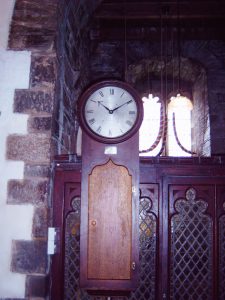.

Egloskerry church clock: an article written by Mr Antony Lovett, Tregada House.
Not a great deal is known about the clock suspended inside the church on the tower screen, and also as to how it came to be there. A few facts can be noted of interest, and some speculation advanced, but of certainty, there may be some doubt. People of the Parish and congregation may be interested in the foregoing and are invited to feel free to question it thought inaccuracy is present.
On the clock itself, it is recorded that it was made by William Reynolds of Launceston, who with his two sons to follow were local clockmakers in Westgate Street and later Church Street between 1823 and 1873. In those days, clocks were often bespoke made to a buyer’s specification, or by a retailer for resale. The movements would be purchased from one source, the dials from another, and then a cabinet maker creating the cases. The clockmaker would assemble and then set up the clocks in place. Sometimes clocks were specially made to fit awkward places in houses and cottages, and often the name on the dial would be that of the buyer or of the clockmaker or both.
From markings on the inside of the dial, Egloskerry Church Clock was made and supplied in 1834, probably for a special location since the winding is from the rear, and not through the front of the dial by way of winding holes which is the most usual, but which does not always enhance the dial appearance. This clock might well have been made for a hinged opening cupboard door or similar location peculiar to a home. [sic].
Repair, overhaul, and service marks appear as follows: W Sobey Aug 1905.
G Parsons Oct 1909 WM {?} Oct 1926
G Lovett June 1990 L Haymes May 2004.
A trusted and well-loved member of the congregation has advanced the possibility that the clock may have had its origin in the original Vicarage which then occupied the lane immediately to the east of the church. The clock may have been given to the church by the then vicar, The Rev W Sloane-Evans when the new present vicarage was built in 1873. This would appear to be a strong possibility, but not known for certain. The clock having no front dial winding facility precludes it a front wall hanging, hence the reason it hangs where it does. Thankfully, a regular and trusted member of the congregation attends to winding and correcting on a weekly basis, and this is appreciated by all who enjoy telling the time, and hearing the tick-tock from this timely old piece. It might also be said that the clock sited as it is, acts as a length of a sermon monitoring device for preachers who might be tempted to get carried away! If there is anyone in the village who can correct or able to add to what I have written about the clock please do contact me and put me right.
Visits: 172
